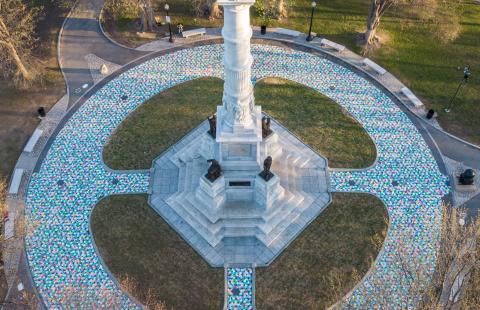What were the specific goals of this creative economy project? Describe the community development challenge or opportunity that your project was designed to address:
JArts uses the arts to bring people and communities together across geographic and cultural barriers.
Our lead goal of Pathways to Freedom was to delve into the particular story of freedom and immigration as told through the Jewish holiday of Passover, and highlight it as an example of the universal experience that is understood by people across Boston - an area comprised of people who have come here from many places.
We aimed to create a program model that was designed to engage community groups and individuals to come together for a common experience. By commissioning an artist who was not only able to create a beautiful and engaging end product, but one whose process is rooted in community engagement and "data" collection enabled us to reach deeply into the community and bring about a common conversation about and appreciation of freedom.
We sought to engage 1,500+ people across geographies, languages, and socio-economic levels in an important timely dialogue, and reveal its relevance to all. Artist Julia Vogl was able to reach 1,800 diverse community members because the project was mobile - bringing a cart with all the materials to the 27 different community encounter hosts/neighborhoods. Additionally, the four questions that were core to the project were translated into 7 different languages as to lower as many barriers as possible.
We aimed to create a project that had a beautiful, well crafted and high visibility end result, and that was equally rooted in community engagement and dialogue.
If the goals change over time, please describe how:
The goals of this project were consistent. Recognizing early on that community participation was central to the project's success, what grew was our focus on community outreach. Our success in reaching such diverse groups, and enthusiasm from them, led us to engage with far more individuals than we originally anticipated. JArts intends to continue working with the theme of freedom on a public art project annually. In spring 2019 we will be creating a project around Passover and National Poetry Month, featuring a Jewish freedom themed poem on MBTA poster and social media campaigns, all to be supplemented by a community toolkit to continue to enable our community partners to engage.
Who was involved in this project and what did they do? (be sure to include the partners from outside of the creative sector and how local voices were included):
Artist Julia Vogl imagined and implemented the entire project. JArts staff developed and produced the project in partnership with JArts leadership, fundraised to make the project possible, and developed all relevant partnerships. JArts leadership, inclusive of our board and Art Think Tank, leaders helped make community connections, raise funds, and support the artist with all needs. Boston Building Wraps printed the material for the final product, installed it, worked with local partners to ensure a smooth process. 32 community partners included arts institutions, community groups, cultural groups, development companies, small businesses, and local government. These partners hosted events and helped promote the project to their own communities. Boston Parks Dept was a critical partner in the siting and installation of the final piece. Boston Arts Commission leaders were critical advocates to getting the piece sited. City officials, in addition to Boston City Hall hosting an encounter, helped facilitate connections in various neighborhoods. Boston Properties was a main sponsor and host of the project. Art Week was a major promotional partner, taking place during ArtWeek. Media partners, including WGBH and WBUR as well as others, played roles as sponsors, covering the project throughout the process and bringing awareness throughout our community.
How does this project relate to a larger community development strategy?
Public art not only beautifies our region - it provides much needed space for community dialogue and engagement. Throughout the project, community partners and participants told us what a unique, special, and opportunity this was. The project relied on the participation support of people from across sectors – parks, developers, young and established cultural organizations, media, and more – and brought them all together to work towards a common goal. By bringing 25,000 people into this conversation, we were able to show the strength and vibrancy of the entire Greater Boston area in a meaningful way. This success was noted by area politicians, developers, businesses, and community organizations.
While Boston has started to become more of a public art city, there are few/no opportunities of this caliber for such geographically diverse audiences to all participate in a project like this that are on a large scale and that encourage diverse community involvement.
What projects or places, if any, inspired your approach to this creative economy project?
This project was motivated by a desire to put Jewish culture, and its intrinsic universal values, in a public space. This drew us specifically to Boston Common, not only the iconic and highest traffic part of Boston, but also a space that has represented freedom for hundreds of years. The concept for the piece was inspired by a combination of the Cow Parade model, Play Me I’m Yours street pianos, and the 2010 Sukkah City international design competition project.
We commissioned Julia Vogl because of her track record of creating projects similar in concept across the world, using community input and social "data" to bring communities together. Her "Home" project in Peckham, London and Tysons Tiles" project in Tysons Corner, VA were guiding examples of works that brought community voices together to discuss important regional issues - and to highlight them in ways that allowed all to take pride in the pieces.
